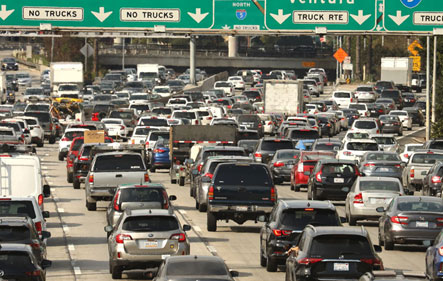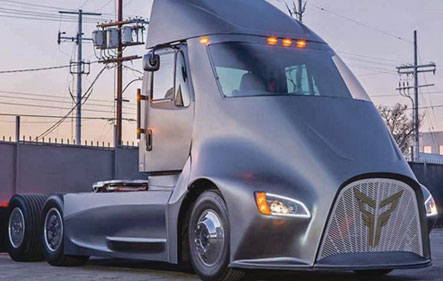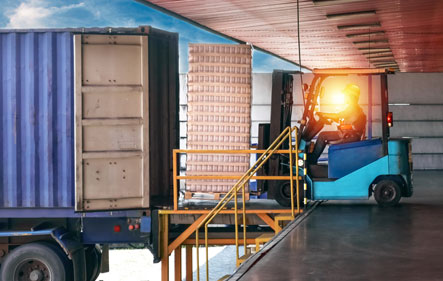With the onset of decades-long droughts, epic rains and floods, tornadoes, snowstorms and other weather-related events, America has awakened to the uncomfortable reality that climate change is here. And for the people whose lives have been forever changed by these events, they just want a return to normal. But the Inconvenient Truth may be that where we are now IS the New Normal and we must make major efforts just to maintain this less-than-ideal status quo.
Thanks to the Biden Administration, the Inflation Reduction Act is seeking to be this generation’s Moonshot – reducing greenhouse gasses (GHGs) to 50% below 2005 levels by 2030 while transitioning America to a clean energy economy. No small task.
Transportation is the biggest source of pollution in the US, so it’s the natural primary target for meeting this ambitious goal.

Biden has called for 50% of all new vehicle sales to be electric by 2030 and the administration is bankrolling a plan for a national EV charging infrastructure that will encompass all 50 states plus Washington DC and Puerto Rico. That’s a good start, but it doesn’t address a key source of transportation pollution. Trucks and buses make up only 10% of vehicles on US roads, but they are responsible for 30% of GHG emissions. The obvious solution is to electrify the trucking and heavy transport industry as a key component in the climate change battle.
Not surprisingly, California is leading the charge in the effort to impose electrification standards on the trucking industry.
In April, the California Air Resources Board (CARB) voted to require all new medium- and heavy-duty fleet vehicles sold or registered in the state to be zero-emission as of 2036. The Advanced Clean Fleets rule encompasses every type of vehicle from cargo vans to buses to long-haul trucks. It also dictates the end of diesel truck sales by 2036, revising a previous target date of 2040. Other noteworthy (and very ambitious) targets included in the rule are:
- • A minimum 50% of state and local agency vehicle purchases must be zero-emission vehicles (ZEV) by 2024
- • Drayage vehicle (trucks transporting cargo from ports to nearby distribution centers) purchases must be 100% ZEV by 2024
As with any major effort, the devil is in the detail.
Drayage trucks, which run short, regular routes that require less battery range and operate out of centralized locations which can enable easy charging, are a logical initial target for truck electrification. At the ports of Los Angeles and Long Beach these trucks travel an average of 50 to 100 miles daily. Long Beach sees approximately 6,000 trucks in and out of the port every day.
Where the Rubber Meets the Road

Electric trucks are available today and are being purchased by fleet operators to meet the changing regulations. But these fleet operators face challenges. Electric trucks are as much as 10,000 lbs heavier than their diesel counterparts. With Federal weight limits of 80,000 lbs for a loaded truck (with 2,000 lbs more allowed for electric trucks), that means drivers may have to carry less cargo.

Coupled with reduced loads are range realities. As any EV driver knows, the estimated range of an EV isn’t necessarily your actual driving distance. Weather and road conditions can impact range, as well as the way a driver operates their EV. For electric trucks, range may be stated as 200 miles but the real range may be significantly less. That can mean fewer trips for drayage trucks. Fewer trips and less cargo translates to less profit, which is a tough pill to swallow for any business owner.
Compounding the challenge of truck electrification is a lack of adequate charging infrastructure. According to California Energy Commission estimates, supporting the anticipated 180,000 electric trucks expected on roads by 2030 will require installing 157,000 chargers. Meeting that requirement means installing 52 chargers every day for seven years. How many electric charging stations are at California’s busiest trucking locations? At the Port of Long Beach there are currently … two.

Adding to the challenge of installing these stations is powering them. Many current EV charging stations offer fast charging at around 150 killowatts for passenger vehicles. Fast charging for a semi-truck could require close to a full megawatt.
Daimler Truck North America, the leading heavy-duty truck manufacturer in the US, has announced a joint venture with NextEra and Blackrock to build a national network of charging stations that are capable of supporting medium- and heavy-duty electric vehicles. That’s an essential first step, but is it enough? According to a study by National Grid, an electric and gas utility, a charging installation serving both cars and trucks along a highway might need to provide around 19 megawatts of peak power by 2035. That’s roughly equivalent to the power needs of a small town. Today, the US power grid is struggling just to meet the nation’s current needs. The national grid is not a single, massive power plant. It is not a uniform, synchronized entity – it is actually an aging network of transmission wires, substations and transformers tenuously linked by 3 interconnections -- Western, Eastern and ERCOT. And it is being eroded at an accelerating rate by hurricanes, wildfires, floods, heat waves and deep freezes. Security threats also pose a challenge.
It all sounds rather impossible, right? But don’t forget, so did putting a man on the moon within a decade. And the need to meet this milestone is about much more than national pride.
Life Support
The Ports of Los Angeles and Long Beach contribute significantly to poor air quality in the region. The LA Basin and the Inland Empire are two “bowls” nestled withing the mountains of Southern California. Air pollution from cars and trucks gets trapped in these bowls, making for some of the worst air in the country. In fact, the LA – Long Beach area has the highest level of ozone pollution in the US.

All that bad air translates to greater health risks. According to Long Beach Mayor Rex Richardson, residents living closest to the ports and freeways have a life expectancy that’s 14 years shorter than those living further away. Even nearby communities like Carson and Wilmington rank in the 99th percentile in California for asthma-related emergency room visits.
The link between air pollution from heavy-duty trucks isn’t specific to the LA area. Areas that have increased truck traffic also tend to be industrial locations that are home to oil refineries and chemical facilities. Residents in these areas are at greater risk of health problems caused by particulate matter air pollution. Reducing these risks by replacing diesel trucks with zero-emission vehicles will save lives and reduce costs. For California, CARB estimates the new regulatory standards will save $26.5 billion in statewide health benefits. Yes, that’s a breath of fresh air, but it won’t come cheap.
The Cost of Cleaner Air
While the conversion of the trucking industry to electrification may save lives, some worry that it will come at the cost of small businesses. According to Matt Schrap, CEO of Harbor Trucking Association, instituting the CARB regulations will result in a road “littered with the corpses of businesses that no longer are going to be able to afford to do business in California”.
Of the more than 30,000 drayage trucks operating in California, 80% of them are owner-operators. For independent owner-operators with a single rig, and even fleet operators, the CARB regulations may indeed be a challenge. The price tag for electric trucks can be as much as $500,000 with taxes and fees. That’s more than twice the cost of a diesel engine truck.
There are incentives and rebates to offset the cost of going electric, but are they enough? Current incentives include:
- • An Inflation Reduction Act tax credit of up to $40,000 for battery-electric trucks and 30% of the cost of a charger
- • A California rebate of $120,000 for battery-electric big-rigs
- • Up to $410,000 to replace an old diesel rig with a battery-electric truck
For the independent owner-operator who’s just paid off his or her rig, are they willing, or even able to go into debt again? Can a fleet operator with a dozen vehicles afford the cost of replacing that fleet?
Fortunately, there are evolving business models that may offer the bridge these smaller businesses need to make the transition to electric.
Forum Mobility, a Bay Area company that provides clients with zero-emission trucks and vehicle charging for a monthly fee – dubbed its “truck-as-a-service” model -- plans to create a network of centralized depots that can house and charge 50 - 150 trucks from multiple fleets. Forum Mobility currently has a partnership with Hight Logistics, a family-owned fleet operator with 50 vehicles. Hight has already added 4 battery-electric trucks and 3 charging stations through its partnership, and plans to increase its fleet to 10 battery-electric trucks with five 2-port charging stations. Forum Mobility is targeting a 2024 goal of 500 chargers across California through a recently announced $400-million joint venture.

The Advanced Clean Fleets rule is a challenging milestone to meet, but even with its ambitious timeframe, with the right talent and resources in place, it may not be an impossible goal. And that’s a good thing. With record-breaking rates of sea-level rise, year-round wildfire season, and more severe weather events all happening now due to the climate, we can’t afford not to implement dramatic changes as quickly as possible. As UN Secretary-General Antonio Guterres stated last March, “the climate time-bomb is ticking … humanity is on thin ice … and that ice is melting fast”.
END

